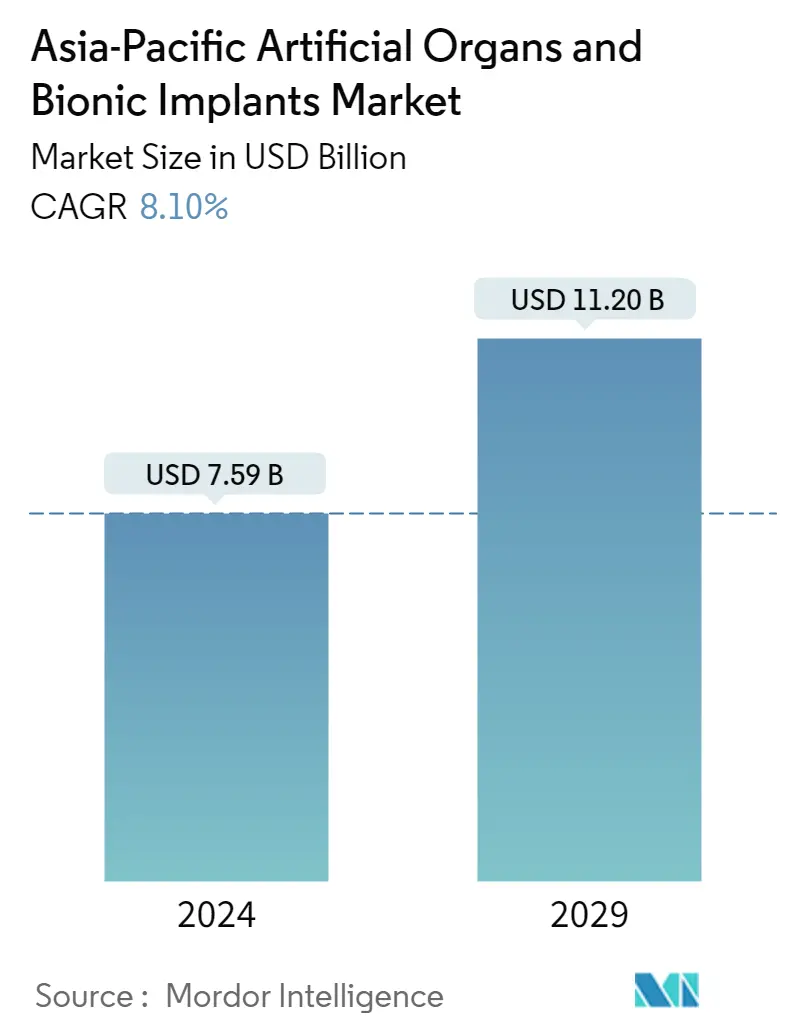Market Size of Asia-Pacific Artificial Organs and Bionic Implants Industry

| Study Period | 2021 - 2029 |
| Base Year For Estimation | 2023 |
| Market Size (2024) | USD 7.59 Billion |
| Market Size (2029) | USD 11.20 Billion |
| CAGR (2024 - 2029) | 8.10 % |
| Market Concentration | Low |
Major Players
*Disclaimer: Major Players sorted in no particular order |
APAC Artificial Organs & Bionic Implants Market Analysis
The Asia-Pacific Artificial Organs and Bionic Implants Market size is estimated at USD 7.59 billion in 2024, and is expected to reach USD 11.20 billion by 2029, growing at a CAGR of 8.10% during the forecast period (2024-2029).
The impact of COVID-19 was severe on the studied market owing to the cancellations of elective procedures, including implants of artificial organs, in the Asia Pacific region. However, the market started to gain traction in the last year as transplants and implant procedures resumed in the region. Also, the piling up of elective procedures involving artificial organs and bionics is projected to augment the market during the forecast period.
In addition, the increased incidence of disabilities, the rising number of road accidents, and technological advancements in products leading to enhanced applications are positively affecting the growth of the studied market.
As the number of disabled people grows, so does the demand for bionic implants, which are prosthetics with both mechanical and robotic elements that replace broken body parts such as hands, legs, limbs, and so on.
As per the Road Accidents in India report, the number of traffic accidents in the country has increased from 3,68,828 in 2020 to 4,22,659 in 2021. The region's high rate of road accidents, as well as rising injury and trauma, is driving market growth.Furthermore, the growing geriatric population, which is more prone to organ failure, is expected to drive growth during the forecast period.According to the United Nations ESCAP, the Asia-Pacific population is aging faster than any other region in the world. In the current year, there are 630 million people aged 60 and up, accounting for 60% of the world's elderly.By 2050, their number is projected to increase to 1.3 billion. The increase in the trend of the population will help boost the overall market growth.
Various groups of national universities, hospitals, and companies are engaged in a collaborative research and development program to develop artificial organs, which is also funded by the government authorities and the businesses. For example, as part of the Australian federal government's budget announcement in May 2021, Monash University researchers secured Medical Research Future Fund (MRFF) research funding in areas such as maternal health, rare cancers and diseases, silicosis, and nutrition and well-being in remote communities, with the Artificial Heart Frontiers Program receiving USD 999,570 in 2021 for the development of artificial hearts.BiVACOR is also funding and collaborating on the initiative to develop and market a total artificial heart.Such partnerships and research developments are anticipated to boost market growth during the forecast period.
Therefore, owing to the aforementioned factors, it is anticipated that the studied market will witness growth over the analysis period. However, the expensive procedures and fear of device malfunction and its consequences are likely to impede market growth.
APAC Artificial Organs & Bionic Implants Industry Segmentation
As per the scope of the market, artificial organs and bionics are man-made devices that can be implanted or integrated into humans to either replace a natural organ or provide support for the purpose of restoring a specific function or a group of related functions, helping the patient return to his normal life. The Asia-Pacific Artificial Organs & Bionic Implants Market is Segmented by Product, Artificial Organs (Artificial Heart, Artificial Kidney, Artificial Liver, Cochlear Implants, and Others) and Bionics (Vision Bionics, Ear Bionics, Orthopedic Bionic, and Cardiac Bionics), and Geography (China, Japan, India, Australia, South Korea, and Rest of Asia-Pacific). The report offers the value (in USD million) for the above segments.
| By Product | |||||||
| |||||||
|
| Geography | |
| China | |
| Japan | |
| India | |
| Australia | |
| South Korea | |
| Rest of Asia-Pacific |
Asia-Pacific Artificial Organs and Bionic Implants Market Size Summary
The Asia-Pacific Artificial Organs and Bionic Implants Market is poised for significant growth over the forecast period, driven by a combination of factors including the increasing incidence of disabilities, road accidents, and technological advancements in medical devices. The market, which experienced a setback due to the COVID-19 pandemic with the cancellation of elective procedures, has begun to recover as these procedures have resumed. The demand for bionic implants, which integrate mechanical and robotic elements to replace damaged body parts, is on the rise, particularly as the geriatric population grows and becomes more susceptible to organ failure. Collaborative research and development efforts, supported by government funding and partnerships among universities, hospitals, and companies, are further propelling the market forward. These initiatives aim to develop advanced artificial organs, such as artificial hearts, to address the growing need for organ transplants and mechanical circulatory assistance.
India is expected to hold a significant share of the market due to its rising number of disabilities, road accidents, and a growing elderly population. The country is witnessing increased technological advancements and research projects focused on developing affordable artificial organs. Notable initiatives, such as the development of the Left Ventricular Assist Device (LVAD) by IIT Kanpur, highlight the region's commitment to advancing medical technology. Additionally, the market is characterized by a slight consolidation, with key players like Ossur, Boston Scientific Corporation, and Medtronic plc holding substantial market shares. The introduction of specialized dialysis equipment and home hemodialysis services further underscores the market's expansion. Regulatory approvals and technological milestones, such as the approval of the CH-VAD LVAD in China, are expected to enhance the commercialization of new-generation devices, thereby boosting market growth across the Asia-Pacific region.
Asia-Pacific Artificial Organs and Bionic Implants Market Size - Table of Contents
-
1. MARKET DYNAMICS
-
1.1 Market Overview
-
1.2 Market Drivers
-
1.2.1 Increased Incidence of Disabilities and Rising Number of Road accidents
-
1.2.2 Technological Advancements Leading to Enhanced Applications
-
-
1.3 Market Restraints
-
1.3.1 Expensive Procedures and Fear of Device Malfunction and its Consequences
-
-
1.4 Porter's Five Force Analysis
-
1.4.1 Threat of New Entrants
-
1.4.2 Bargaining Power of Buyers/Consumers
-
1.4.3 Bargaining Power of Suppliers
-
1.4.4 Threat of Substitute Products
-
1.4.5 Intensity of Competitive Rivalry
-
-
-
2. MARKET SEGMENTATION (Market Size by Value- USD million)
-
2.1 By Product
-
2.1.1 Artificial Organs
-
2.1.1.1 Artificial Heart
-
2.1.1.2 Artificial Kidney
-
2.1.1.3 Artificial Liver
-
2.1.1.4 Cochlear Implants
-
2.1.1.5 Others
-
-
2.1.2 Bionics
-
2.1.2.1 Vision Bionics
-
2.1.2.2 Ear Bionics
-
2.1.2.3 Orthopedic Bionic
-
2.1.2.4 Cardiac Bionics
-
-
-
2.2 Geography
-
2.2.1 China
-
2.2.2 Japan
-
2.2.3 India
-
2.2.4 Australia
-
2.2.5 South Korea
-
2.2.6 Rest of Asia-Pacific
-
-
Asia-Pacific Artificial Organs and Bionic Implants Market Size FAQs
How big is the Asia-Pacific Artificial Organs and Bionic Implants Market?
The Asia-Pacific Artificial Organs and Bionic Implants Market size is expected to reach USD 7.59 billion in 2024 and grow at a CAGR of 8.10% to reach USD 11.20 billion by 2029.
What is the current Asia-Pacific Artificial Organs and Bionic Implants Market size?
In 2024, the Asia-Pacific Artificial Organs and Bionic Implants Market size is expected to reach USD 7.59 billion.

